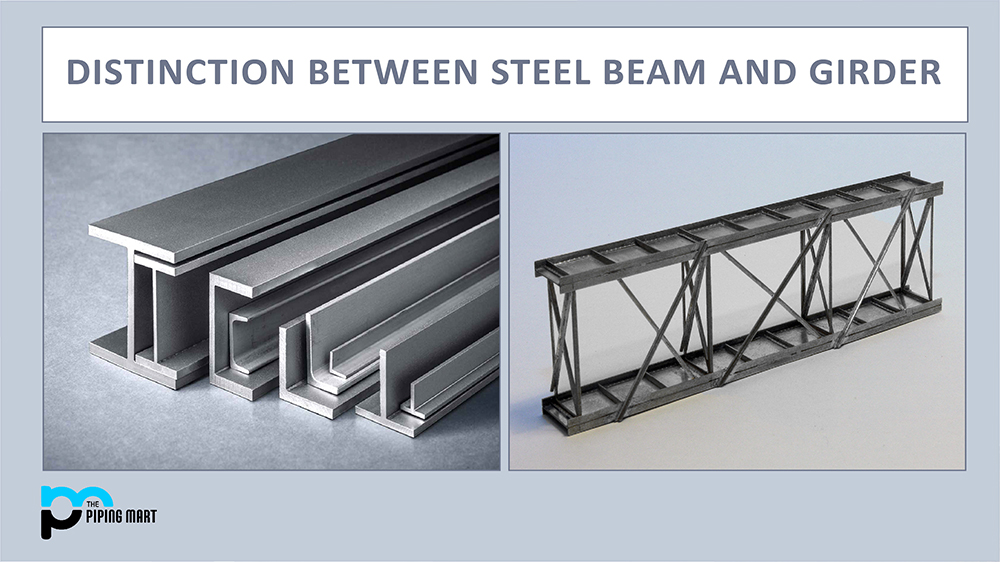The American Concrete Institute (ACI) Code, a leading authority for inspection, project management, and consulting for people and organizations involved in construction and concrete design, specifies all structural materials for reinforced concrete and the standard acceptance tests for such materials. The ACI periodically revises its requirements to accommodate advancements in testing, materials, and production techniques. In structural systems, specifically in the 1995 ACI Code, beam and girder are the two widely utilized codes. Both bear flexural loads and serve as the main components of the structural frame system. They are both horizontal members and some of the most often used building components. Even though both names are frequently used synonymously, there are some differences between them.
What is a Beam?
A beam is a fundamental component of a structural framing system that is specially made to support distributed loads, like parallel walls or roof systems. One of the most often used structural components in engineering, beams are intended to withstand loads, and their main deflection mechanism is bending. It is primarily utilized to withstand shear forces, vertical loads, and bending moments. As a result, the primary requirements for designing a structure are used to compute the bending moments that give beams their definition. Simply put, a beam is any horizontal structural member that can withstand load and is subject to lateral load.
What is Girder?
A girder is a beam that serves as the primary horizontal support of a structure and supports smaller supporting beams. Girders have a substantially higher load-bearing capacity than beams and are intended to handle large concentrated loads like columns or beam responses. Concrete, stainless steel, or a combination of the two are just a few examples of the building materials that can be used to create it. It can be made of a single piece, or several pieces joined together and supported by vertical loads.
Difference between Beam and Girder
Basics of Beam Vs. Girder
One of the most often used structural components, beams, is horizontal parts to support distributed loads like parallel walls or tributary regions of the floor and roof systems. It is a structural component that can support loads in construction projects, primarily via bending. Despite its common name of “girder,” a beam that supports other beams is still a beam. Girders support smaller beams and serve as a structure’s immediate horizontal support. They are made to handle heavy, concentrated loads like columns or beam reactions.
Size of Beam Vs. Girder
The size of the component is what distinguishes a beam from a girder. In the construction industry, beams are frequently referred to as girders, which serve as the primary horizontal support framework for smaller beams. So, while all girders are beams, not all beams are girders by definition. Both are bending members, their only difference being how they are loaded. A girder is the major structural support made up of smaller beams. The Code does not provide rigid guidelines on the measurements that separate a beam from a girder.
Types of Beam Vs. Girder
Beams are divided into various engineering types based on various factors. Beams are categorized into the following types according to the type of support: supported, fixed, continuous, cantilever, and trussed. Based on their geometry, beams can be categorized as straight, curved, or tapered beams. Beams are classified as I, T, and C beams depending on how their cross sections are shaped. Typically, a steel beam is referred to as a girder. The most typical kind of girders used in bridge construction is I-beam girders. The construction of elevated bridges and road flyovers primarily uses box girders.
The functionality of Beam Vs. Girder
Beams and girders are horizontal elements with bending as the only deflection mechanism to support structures. Beams are used in floors, walls, ceilings, roofs, and decks to support the structural integrity of buildings, primarily residential ones. Because of their remarkable load-bearing capacity under all circumstances, beams are the preferred structural member. Because they can handle incredibly enormous loads, girders are primarily employed to support smaller beams and are frequently utilized to build bridges and flyovers. As girder bridges, the most popular and straightforward type of bridge utilized in construction, girders are typically used as box or Z shape members.
Summary of Beam Vs. Girder
While girders are also horizontal parts that support smaller beams but serve as the primary support of a structure with dynamic load-bearing capacity, beams are regarded to be among the most often constructed structural elements. Nevertheless, beams go by several names depending on where they are in a system and the material they are made of. For instance, a basic floor joist is a lightly loaded beam, and a roof joist, often known as a “rafter,” is a beam.
A girder is a type of beam that supports smaller beams; while it is still a beam, it has a significantly higher load-bearing capacity than a beam and is intended to sustain large portions of a structure. As a result, beams are best for residential constructions, whereas girders are typically utilized to build bridges and flyovers. In other words, all beams are not necessarily girders, but all girders are beams.

Pipingmart is B2B portal specializes in industrial, metal and piping products. Also, share latest information and news related to products, materials and different types grades to help business dealing in this industry.




